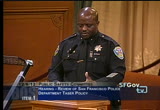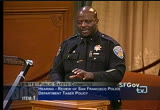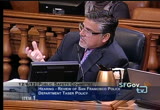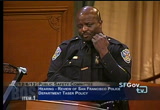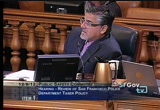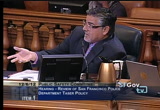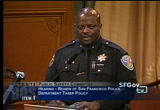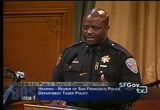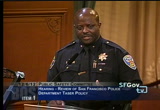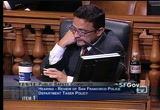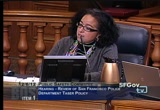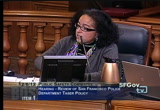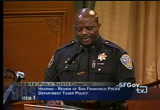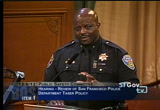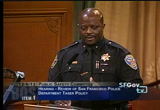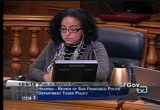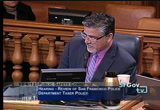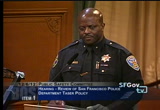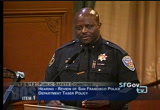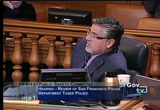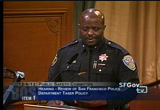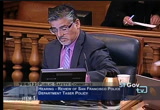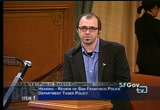tv [untitled] December 27, 2012 12:30pm-1:00pm PST
12:30 pm
also are having the discussions about looking at tasers, what we are looking at is if you look at every tool that i have on my gun belt, do you see a very lethal tool in the sense of a firearm. everything else is about paying compliance. you are dealing with a person in crisis, and pain is often times and you compliment that crisis with substance abuse through alcohol or otherwise, and you have diminished pain reception. even dealing with folks who have a history of mental illness, there is a reduced pain perception in many instances. with that being said, do i want to use weapons that are only about pain compliance or use a weapon system that is about controlling and stopping that person from doing any further aggressive behavior than what they are doing and our policy is if you look at the policy. it is not about using the policy against someone who is
12:31 pm
simply non-compliant. that would be a violation of the policy. it is about using potentially that weapon system against someone who is active, state of aggression towards the officers and or the public themselves. so, with that said, it is a weapon system that controls as opposed to uses pain as a means of acquiring compliance. >> i have a couple of follow ups, but i know that the chair has a question. >> actually this probably dove tails with his questions, but for all of us to really understand, could you explain how electronic controlled weapon, a taser works? >> it works by simply, capturing the electrical systems within your muscles and basically constricting your muscles. >> but mechanically, you fire something? >> there are two probes that come out of the weapon system itself creating a positive and a negative contact. once those or once that connection is made, then,
12:32 pm
electricity goes through the person for a cycle of up to 5 seconds. >> how long? >> we are talking about three amps of electricity, i believe, they are at 50,000 volts or so. but it is the amp rage that makes the impact not necessarily the volts itself. but what it does is captures the muscles and keeps the person from doing anything further. >> and have you ever been tased yourself? >> i am schedule to be tased sooner rather than later. the chief has been and i have... based on his experience thus far. >> how do you feel about the posbility of being tase? ? >> i would rather be tased than struck with a baton, we teach all as all do if you are going to deploy the baton you use it against the bony areas of a person's body not the meaty areas, so if i strike you in your petella for instance it is possible that you are going to have long term injuries as
12:33 pm
opposed to the short term pain and control that the electronic control weapon would have. so, personally, i would rather betased than struck with a baton. >> i actually have been pepper sprayed. >> the thought of being tased does that give you any dreptation? >> first of all, i think that from the standpoint, one i am not in the state of crisis and i am not in a state of ago aggrevatio nthe chief has asked me be to the point and the opportunity has not presented. >> someone in the state of crisis, who gets tased does the tase actually have an effect on someone who mental health crisis actually reduce the anxiety? or how does it relate to the level of anxiety that a person in crisis might be experiencing? >> i would suspect that it does not diminish the level of anxiety that this person has. but the point of the electronic control weapon at that point, i
12:34 pm
would suspect would be to control an aggressive, potentially violent person as opposed to controlling someone who is simply in a state of crisis who is not a threat to someone. once again, a policy that we are looking in terms of a draft. it is it has the caviot that it is not about using it for convenience, it is about using the weapon system for a person who is a clear and imminent threat to others and or the officers themselves. >> yeah, and i think and i hear the policy and what i am concerned about is that could be interpreted in a moment by one of our, you know, 1,900 officers plus or minus, and in a moment where it gets used in a way that is not according to what our policy says or this discretion involved that leads to and has an impact on the communities. that is where we can put
12:35 pm
forward all of these case wheres people get killed or people get hurt or in stances where you say that there is ultimate justification for it happening but then we find out the cases where it is not. in fact there are cases where guns are used where there is a real great amount of interpretation and sometimes evidence that the guns were not necessary to be used as well. >> supervisor campos. >> i think that addressing that challenge is why the chief wants to make sure that any deployment is done in a very prudent matter and put into the hands of those who are most apt not to use it and those individuals who have been exposed to all of the various components of the crisis intervention training so as it speaks right now, we are looking at 102 members of our department who would in fact be eligible if it was approved. >> thank you, mr. chairman and thank you. we have a quick follow up. in terms of the mechanics of how it would work, am i
12:36 pm
mistaken in assuming that if you do have this pilot in conjunction with the use of tasers you would also have defibrillators available? >> yes. >> can you explain to me how that works and why there is a need to do that? >> it is one of the recommendations that came out from the physician, the cardologyist with the university of california, san francisco. was that if we are to deploy an electronic control weapon it should be done in conjunction or the availability of a defibrillator should be immediate and with that said, the department is also moving forward with a community members who want to see independent of the taser issue, it is something that actually was a part of the discussion before july when the chief brought this issue up was there was a discussion, already, about adopting a police car or
12:37 pm
donating a aed and having that device available in a police car and no cost to the city for a period of some six years. >> can you explain to me what to do any member of the audience what a defibrillator is? >> i'm looking around to see if i see one and in most of our buildings we have them. dispersed and they are within the police department and certainly within the city haul. it is basically for a individual who has a heart stoppage and basically you place the device on the chest of the person, and that device measures all of the activity of that person's body and applies a charge to start their heart if necessary. it is not a choice, that the officer or the operator should say, makes. >> to me, the fact that you need a defibrillator points to the underlying danger here. that if tasers are so safe, why do you need to have a
12:38 pm
defibrillator available? >> it was the recommendation that came from one doctor. although there is not a single. there is one case out of arizona where the medical examiners identified tasers as being the cause of death. and every single other case there are a multitude of issues surrounding the in-custody death but not one that has been identified as being caused by electronic control weapons. >> but with that said, it is a matter of what safe guards can we put in place in the event that one is used and there is an issue with a short shopage. >> and that is my point, defibrillators are to treat life threatening. if we are trying to replace a lethal weapon a gun with a non-lethal weapon, we are talking about replacing a gun
12:39 pm
with a taser where because of the potential lethality of it you actually have to have this instrument available in the event that there is a life-threatening incident. that is the problem that i is that you know, in theory, even if you agree with the concept that you go and you replace a life threatening instrument or tool with something that is non-life threatening i don't know that we have that here. we are talking about a doctor saying that you need to have this instrument available in terms of liability. i think that we probably would have a baig issue of liability if that was not available. and so, so there is... it is not like we are replacing a gun with something that is not non-lethal, really. potentially. it is potentially could be lethal and so that to me, the fact that you have to have this instrument tells you, the danger, here. thank you. >> commissioner, supervisor
12:40 pm
olague? >> i guess, i think that you really gave the argument of why it is so important to really encourage and continue to strengthen the cit program because you know, definitely, i think that that is why resources should go. rather than train 103 people and having to invest in that additional weaponry even though it is supposed to be donated there are things that we have to pay for. then, i think that those resources should be definitely going into a different conversation around american tal health crisis and i think that is what distubers me the most. how we strengthen cit and train everyone in the police department to make sure that it is part of the curriculum of how to respond to someone who is in a mental health crisis mode, which i believe could be a public safety issue, yes. but i believe that it is also a
12:41 pm
public health issue. and i visited a couple of occasions, the psych ward of sf general and i have talked to a lot of the folks there who deal with people in extreme situations. but i think we also read more when the economy was failing a lot of folks who never had any history of mental health. and crisis, or illness, had a lot of moments where they reached a mental health crisis just over the stress over the economic stresses in their life. so, i guess, ultimately, what i'm saddened by is that we are here in one of the most progressive cities in the world allegedly, and we know that we have a population who, you know, who in all cities, really you have populations of people who with or without a history may lead to mental health crisis situation and that the conversation goes to taser use rather than reevaluating and
12:42 pm
reflecting on how we can create a culture that has to do more with a different type of crisis intervention. so i just think that the idea of a weapon. of continuing to go down that path of using a weapon is not the conversation that is a good conversation to be or a healthy conversation to be having in this city, that is all. and i thank you for your work on the cit and i trust your work and you do good work and i hope that we get to a point where everyone in the department can be having that training that it is more than four times a year. and that it is just again, part of the curriculum and that we have just a different conversation about how we engage with people who are in that state. >> supervisor, just to assure you, you are having that conversation. >> okay, great. >> if you look at the fact that we... our department deals with over 4,000 non-involuntary commitments to san francisco psychiatric services through 5150 holds.
12:43 pm
we also deal with the significant amount of numbers of diversions, we have a policy with the door clinic with a number of our officers, where we see a person who is potentially at the crust of being a threat to themselves or others, there is an intervention that allows us to not allow that to go further or become a criminal issue or become a psychiatric hold issue and we divert the persons to the clinic. the important thing to know is that a significant number of our calls to service were relative to persons who do have a mental elth issue and who are in a state of crisis come from the medical practitioners themselves. we are talking about not... the identification of the person, but the identification of the behavior. behavior has gone from a person who is managing some mental illness to a person who is now
12:44 pm
a threat to potentially to themselves and or others. and when they came a threat to others, that is when the medical professionals call us. and it is that point, that we have to recognize, that words do not always work. and the words of trying to capture the attention to someone who is in crisis does not work. if the medical professionals have difficulty doing it and have a multitude of degrees behind themselves in training, we cannot expect our officers to be able to offer the words that is going to connect with the person in the crisis and keep them from going into a position of danger to others. when that takes place, our officers need to be equipped with the available tools in order to lessen the... >> for a second, i would like to keep the audience, respectful of people's spaoeblging speaking at the podium. i think that it is respectful and that i want to be able to take part in.
12:45 pm
i ask that we do not clap and i hope that people can refrain from that. >> and i guess, you know, i thank you for that. but i guess finally, i am a delayed person, when we read about some of these situations that involve like i guess, box cutters and others things it is kind of to understand and at some point i should do my own sort of exploration of this, how is escalates from that to someone dying. someone being shot. >> supervisor, i have seen people who have died as of the result of box cutters. >> i am just saying, thank you. >> thank you. >> supervisor mar. thank you, i just wanted to ask commander ali about the costs of implementing the program and so how much would the pilot program cost, but also include the cost of defibrillators and
12:46 pm
also, the training involved in the pilot program, how much is that going to cost? >> well i am actually the point person for the aeds and the cost there are going to be absorbed by the persons who are donating them to the police department, in fact we have a relationship with fssafe, if you look on thir website you can click on their website and make a donation to sf safe and they in turn are purchasing the defibrillators that would be donated to the police department. the cost of the initial price is ininclusive of all of the costs associated with the deployment of the aeds and cover 206 years in terms of the cost. the cost of the unit itself with replacement batteries and the replacement cups and so forth. the cost of the tasers has not been completely vetted at this point, we know roughly that each unit and it is somewhere
12:47 pm
around 1,000 a unit. >> and then the training? >> so, has this department have budgetary license to be able to make a purchase? is it in your budget already? as a line item or something that you will be coming to the board for at a later date. >> i don't believe as far as the budget currently. it would be something that obviously would have to be presented. >> in the pilot program, could not be enacted during this fiscal year. because there has not been a budgetary, allocation of having a pilot program on tasers. >> i am not 100 percent, i am not in charge of the fiscal unit. >> it would be got to get an estimate of how much it would cost. some donated, and through san francisco, for everyone or other resource and then the training hours involved. if you could give us at a later time an estimate of how much
12:48 pm
that would cost that would be helpful. >> absolutely. and just to let you know, the defibrillators are moving forward independent of this discussion about electronic control weapons. we intend to place as many units in patrol cars as we possible can and a multitude of reasons. our officers are often times the first on the season of medical calls for service and in deploying that, we hope to save lives as that has taken place across the country. supervisor olague? >> i think that it would be good and i don't know what the composition will be in the future but to have a informational session or a hearing on cit and just how it is implemented and you know, all of that, so just wanted to put that out there. >> actually i was considering that. sure. >> it is a good point. >> supervisor campos. >> i don't know if it is an
12:49 pm
answer or something that the police department can do and the city attorney can help us with, do we have any information on any liability that have been used on jurisdictions that have used tasers? do you have any information about what kind of liability has been found against any jurisdiction involving the use of a taser? do you know that? >> i know a few but i have not done any comprehensive analysis of that. no. >> i think that it would be helpful for us, as a city to have information on that. and i don't know that the best way to kind of compile that information, but i think that that is certainly something that i would be interested in learning. >> thank you. >> we can do that. >> just lastly before going on to public comment and perhaps we will have you back and respond to the questions or issues that come from the public comment. >> but looking at the letter that the aclu has written to the mayor, i think that it is a
12:50 pm
lot of good points in here, they talk about liability as well. this is one paragraph, if you don't mind my reading despite advocacy by police departments and taser international, taser use remains highly controversy and studies have called into question the weapon's safety, in particular against high risk populations such as those with mental illness or those under the influence of drugs, the lifrn between elevated risk of serious injury and these populations should raise serious concerns for officials grapling with health on the streets. one recent study and this is the university of central florida. one has shown that citizens were injured 41 percent of the time when they were used as the only type of force and 47 percent of the time when they were used in conjunction with another form of force, compared to people being injured, 29 percent of the time when no taser was used what are your thoughts about that.
12:51 pm
>> when there is no taser used there is less injury that happens in making contact with people. >> you know, it is funny i actually have data that shows the opposite. i have contacted, for instance, the california highway patrol and looked at their data, relative to the deployment and they have done it piece meal, although the force is deployed with this weapon system and what they attracted were both officer injuries and suspect injuries in both categories were less after the dow deployments and i think that there is a number of sets of data out there and unfortunately it is not always an alignment. >> these is around people who are experiencing mental health issues. i think that the law enforcement happens within our 49 scary miles and what happens on our highways is different as
12:52 pm
well. there are number of contributing factors as we look at the 15 officer-involved shootings over a five-year study, seven were non-lethal and eight were lethal. and all 7 cases, there was no detections of any drugs or anything of that nature on board. and on all eight instances medical examiner, discovered multiple drugs on board of the victim in those cases. i think that there are a number of factors that contribute to the injuries that we may be talking about that i don't think will be captured in one paragraph of a report. >> and before we go to the public comment, one last question, what is it now that is driving a push within the department for tasers? is there a... has the human heart changed over the past,
12:53 pm
you know, five years or so? are we seeing dramatic increase in officer-involved shootings compared to what we had before? are we finding that despite what we see in terms of controversy that this is what is considered the best practices? what is actually driving this forward? >> you know, i think that the human heart in particular, the heart of this department has not changed. if you looked at the history, if you look at the history of the department, every chief starting with every chief has asked for tasers, including fong, and temporary chief, and go down and now chief sure. and in each of the cases i think that those discussions were precipitated by an officer-involved shooting that in the hearts and minds of our chief of this organization and looked at the facts of that and
12:54 pm
said that if we have a different weapon system and a electronic weapon control system we would not have to have deployed that force and in this case with the chief sure and i completely concur, that the shooting in july, that had we had a electronic weapon system in place and that person would be alive today and back to the road to recovery. and i think that is conist ent and the reason behind the chiefs bringing this discussion to bear. >> just hearing that i am reminded of when officer... was shot and he was shot by an officer, he said that he thought that he had a taser. and would be applying that. so i don't see it as necessarily as an equation that necessarily equates to the
12:55 pm
officer-involved shootings and we also have the experience of settled and so we do on the board of supervisors and occasionally we have settlements of policing the settlements that deal with the victim of someone at the hands of the police. that comes up. that weapon will lead to other settlement or liabilities that we will have as a city moving for ward. >> that is a big threat and concern, that i think that member of this committee have and certainly the member of the public have has well. >> i think that is precisely why the chief wants to make sure that we adhere to the resolution that we do engage the community and that we are incredibly transparent in terms of what we have in place to safe guard and limit any liability that takes place, i mean, the nature of law enforcement is that it is not without liability. there is something, you can't control everything and some things do not happen according to planned. so how do we make certain, what
12:56 pm
do we do to put in place to insure that our officers are prudent and judicious in their conduct, that is clear, training and oversight for those who are responsible for the engagement and carrying out of the commission. >> we are going to public comment. i am just afraid that we are approaching a lethal cliff and we are approaching a place where we open ourselves up to greater liability by use of tasers. >> let's go into public comment. >> i have a few cards that i can call moving forward. and a few let's see lisa alator. michael gos from the mental health association and mckay davis from the aclu. >> good morning, supervisors and staff, and members of the community. thanks for holding this hearing today. my name is lisa alator i, i am a resident of san francisco and i am an organizer with the
12:57 pm
coalition of homelessness and today i am proud to stand with my community members and my colleagues to say strongly that san francisco does not want tasers and san francisco does not need tasers. >> san francisco police department has been given the chance to set a national precedent in how they respond to crisis situations through the implementations of the crisis intervention team. instead of prioritizing the training and the culture shifts that are necessary to save the lives of our vulnerable populations he is offering a new weapon to be used. numerous studies shows that they are a deadly weapon that do nothing to lower fatality or police shooting victims. in fact we have seen the opposite. you will hear more testimony that highlights lawsuits and respect if i have studies done here in california and nationally that expose the
12:58 pm
harms of trigger happy police officers who rely on force instead of culturally competent deescalation tactics. they need to invest in strategies to support the communities is not lethal weapons. thank you. >> thank you, very much. next speaker, please? >> please, please, refrain from clapping. this is the tone that i would like to set for this hearing and other hearings. >> good morning, i am michael, the deputy director of the mental health association of san francisco. and to start off, i just wanted to thank you guys for having this hearing today and also thank the department, the police department commander ali for the work over the last two years with us as members of the working group who have attempted to implement cit here in san francisco. i know that i don't have much time but over the past two years i have been part of the group of community leaders in
12:59 pm
implementing cit here in san francisco and i think that it is important to clarify that cit is still very much in process, which is why my opposition to tasers, where it comes from. we have had three trainings for cit so far. and it is still is training, it is not yet a team. so i think that is something to be very clear about. we have had three great trainings but as far as the implementation of protocol and working with the department of emergency management and 911 operators and doing follow up and evaluation of effort and debriefing quarterly. those are things that we need to be working on first in my opinion before going to tasers. also, the question of arming cit officers only with tasers is something that concerns me as a mental elth advocate and something who has dealt with it myself. it puts those folks in crisis at greater risk of encountering tasers, not to
96 Views
IN COLLECTIONS
SFGTV: San Francisco Government Television Television Archive
Television Archive  Television Archive News Search Service
Television Archive News Search Service 
Uploaded by TV Archive on

 Live Music Archive
Live Music Archive Librivox Free Audio
Librivox Free Audio Metropolitan Museum
Metropolitan Museum Cleveland Museum of Art
Cleveland Museum of Art Internet Arcade
Internet Arcade Console Living Room
Console Living Room Books to Borrow
Books to Borrow Open Library
Open Library TV News
TV News Understanding 9/11
Understanding 9/11